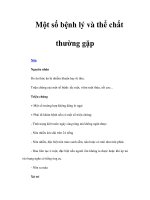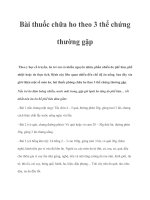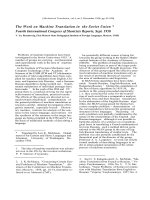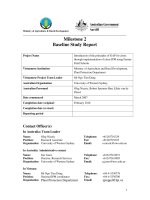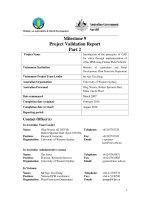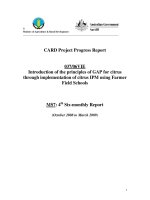The work ethic gap
Bạn đang xem bản rút gọn của tài liệu. Xem và tải ngay bản đầy đủ của tài liệu tại đây (1006.33 KB, 62 trang )
Northern Michigan University
NMU Commons
All NMU Master's Theses
Student Works
12-2017
THE WORK ETHIC GAP: COMPARING PERCEPTIONS OF
STUDENTS, EDUCATORS, AND EMPLOYERS
Joseph Routhier
Follow this and additional works at: />Part of the Vocational Education Commons, and the Work, Economy and Organizations Commons
Recommended Citation
Routhier, Joseph, "THE WORK ETHIC GAP: COMPARING PERCEPTIONS OF STUDENTS, EDUCATORS, AND
EMPLOYERS" (2017). All NMU Master's Theses. 164.
/>
This Open Access is brought to you for free and open access by the Student Works at NMU Commons. It has been
accepted for inclusion in All NMU Master's Theses by an authorized administrator of NMU Commons. For more
information, please contact ,
THE WORK ETHIC GAP:
COMPARING PERCEPTIONS OF STUDENTS, EDUCATORS, AND EMPLOYERS
By
Joseph Routhier
THESIS
Submitted to
Northern Michigan University
In partial fulfillment of the requirements
For the degree of
EDUCATION SPECIALIST
Office of Graduate Education and Research
December 2017
SIGNATURE APPROVAL FORM
THE WORK ETHIC GAP:
COMPARING PERCEPTIONS OF STUDENTS, EDUCATORS, AND EMPLOYERS
This thesis by Joseph Routhier is recommended for approval by the student’s Thesis
Committee and Department Head in the Department of Education and by the Assistant
Provost of Graduate Education and Research.
__________________________________________________________
Committee Chair: Dr. Derek Anderson
Date
__________________________________________________________
First Reader: Dr. Cale Polkinghorne
Date
__________________________________________________________
Second Reader: Dr. Joe Lubig
Date
__________________________________________________________
Department Head: Dr. Joe Lubig
Date
__________________________________________________________
Dr. Lisa S. Eckert
Date
Interim Director of Graduate Education
The Work Ethic Gap
Routhier
ABSTRACT
THE WORK ETHIC GAP:
COMPARING PERCEPTIONS OF STUDENTS, EDUCATORS, AND EMPLOYERS
By
Joseph Routhier
Work ethic has been a constant, but elusive topic for decades. This
study sought to identify the differences in perception of work ethic in
between students, educators, and employers.
Seventy-two
participants observed videos of workers in various tasks and rated the
perceived work ethic of the person in the video by using a sliding
Likert scale. Additionally, participants were asked to comment as to
why they rated the worker the way they did. Quantitative analyses
were used to determine differences in the participant’s work ethic
ratings. Qualitative analyses interpreted respondents’ comments to
better understand the results. Results indicated that while educators
assess work ethic with an eye for improvement and effort, employers
assess work ethic with a focus on effective and efficient completion
of a task. Students lack the experience to judge other’s work ethic
consistently.
i
The Work Ethic Gap
Routhier
Copyright by
Joseph Routhier
2017
ii
The Work Ethic Gap
Routhier
DEDICATION
This thesis is dedicated to my parents, Peter K. and Rose M. Routhier, who gave
me my work ethic and so much more.
iii
The Work Ethic Gap
Routhier
ACKNOWLEDGEMENTS
The author wishes to thank his thesis chair, Dr. Derek Anderson, for his
enthusiasm and constant inspiration; Dr. Joe Lubig and Dr. Cale Polkinghorne, for their
support and encouragement; and his wife, Brooke Clancey Routhier, P.E., for her support
and assistance with the statistical analyses.
This thesis follows the format prescribed by the NMU Graduate Studies office
and the Publication Manual of the American Psychological Association (6th ed.).
iv
The Work Ethic Gap
Routhier
TABLE OF CONTENTS
LIST OF TABLES ............................................................................................................. vi
LIST OF FIGURES .......................................................................................................... vii
INTRODUCTION .............................................................................................................. 1
CHAPTER 1: RESEARCH TOPIC .................................................................................... 2
Research Problem and Justification ................................................................................ 2
Purpose for the Study ...................................................................................................... 5
Research Question ........................................................................................................... 5
CHAPTER 2: REVIEW OF EXISTING LITERATURE .................................................. 6
Theoretical Framework ................................................................................................... 8
CHAPTER 3: METHODOLOGY .................................................................................... 11
Participant Selection ...................................................................................................... 11
Study Design ................................................................................................................. 13
Data Collection .............................................................................................................. 13
CHAPTER 4: FINDINGS ................................................................................................ 17
Limitations and Implications ......................................................................................... 29
Discussion and Conclusions .......................................................................................... 30
Recommendations ......................................................................................................... 36
REFERENCES ................................................................................................................. 39
APPENDIX ....................................................................................................................... 43
v
The Work Ethic Gap
Routhier
LIST OF TABLES
Table 1. Median Work Ethic Scores by Group and Kruskal-Wallis Results….…… 19
vi
The Work Ethic Gap
Routhier
LIST OF FIGURES
Figure 1 Comparison of Work Ethic Values – All Videos…………………………… 18
vii
The Work Ethic Gap
Routhier
INTRODUCTION
The subject of work ethic has been both contentious and elusive in recent decades.
Articles and studies have covered the range of employability skills, soft skills, and work
ethic. Further discussions have varied from defining work ethic constructs to establishing
rubrics so that students are assessed on the characteristics of work ethic. Despite years of
critical banter, there is limited research on why the perception of work ethic is so varied
among the most integral groups – educators, students, and employers. This study seeks to
quantify the difference, if any, between these group’s perceptions of work ethic and
define how those perceptions differ.
What follows is a study that uses short video samples to simulate the brief
observations that might occur in the work place or in the classroom, where a teacher or
supervisor might develop opinions on an employee’s work ethic. While it can be
acknowledged that work ethic has more intangible qualities, this study will ask
participants to consider those that might be visually assessed in a short period of time.
One of the goals in discovering how perceptions of work ethic differ between the
three participant groups is to guide efforts in addressing the frustration between
educators, students, and employers. Findings from this study could be used to develop
professional development opportunities for educators. Similarly, the results could be
shared with employers at workshops or conferences to recommend how to better train
new employees. In short, understanding where people differ in their perceptions of work
ethic, should help shape how those groups work toward a common plan of action.
1
The Work Ethic Gap
Routhier
CHAPTER 1: RESEARCH TOPIC
Work ethic has been a topic of contention for employers, employees, and
educators for generations (Cassidy, 2006; Lerman, 2013; Lipset, 1990; Packer, 1992;
Petty & Hill, 2005; Rosenbaum & Person, 2003; Rosenberg, Heimler, & Morote, 2012;
Wall, 2011). Employers claim a lack of work ethic in new employees. Educators
continue to attempt to implement curriculum changes that will teach work ethic through
Career and Technical Education (CTE), Work Based Learning (WBL) programs, and
School to Work (STW) initiatives (Friedel, 2011;. Griffin & Annulis, 2013; Hull, 2005;
Packer, 1992; Wall, 2011). Employees claim they are already good workers and struggle
to see their supervisor’s concerns (Dunning, Heath, & Suls, 2004; Petty & Hill, 2005;
Rosenberg et al., 2012). Clearly, there remains a lack of coherent communication about
what work ethic is in practice and how best to address the frustration and concern of all
three stakeholders: employers, employees, and educators (Riebe & Jackson, 2014;
Rosenberg et al., 2012).
Research Problem and Justification
This section will define the topic of work ethic, for this study, and give a brief
summary of reports and legislative movements that were key to the work ethic topic as a
national interest.
The concept of work ethic can be traced back beyond the early 1900’s as the
Protestant Work Ethic (PWE). The PWE was a lifestyle of hard work, modest living, and
personal discipline that had religious roots (Lipset, 1990). Today, most people relate to a
more non-secular construct of attitudes and beliefs. In general terms, it is the belief that
one is personally accountable for work done and that hard work is valuable (Hill & Petty,
2
The Work Ethic Gap
Routhier
1995). For this study, work ethic was defined as behaviors that indicate a desire to
complete a task well and efficiently.
While its primary focus was educational in nature, when A Nation at Risk was
published in 1983, it scrutinized the way young people were being prepared for work and
college. This report is considered the precursor to the national attention and subsequent
initiatives that would look to reform the educational system to increase work readiness in
young people (Lerman, 2013).
The Secretary’s Commission on Achieving Necessary Skills (SCANS) report,
released in 1991, was apportioned by the Secretary of Labor. The report was meant to
determine where there were gaps in the preparation of the younger generation for work in
the future. Desired qualities were separated into “fundamental skills” and “workplace
competencies”(Packer, 1992). While the report did site specific gaps in skill sets, it did
not find fault with education so much as it provided a framework of what skills workers
would need to be successful. One suggestion was a SCANS certificate that could have
been awarded to students when they attained the desired competencies. Colleges and
Universities could have used the certificate as part of their placement process, and
employers could utilize it when sorting through applicants. However, in order for that
system to have worked, it would have required change in both arenas. Employers and
businesses would have to be more present and involved in providing working
opportunities for students. Education would need to adopt and implement rigorous
assessments for these skill sets (Lerman, 2013; Packer, 1992).
In 1994, the US Departments of Labor and Education created the School to Work
Act to address the continued gap between existing abilities of the entry-level workforce
3
The Work Ethic Gap
Routhier
and the high expectations of employers. The Act focused on Work Based Learning
(WBL) programs, School to Work (STW) programs, and changes in the middle and
secondary curriculum to include more vocational learning (Brown, 2002).
Legislators continued to encourage schools to work with employers. Efforts to
reform are evident in the continuation of the Carl D. Perkins Vocational and Technical
Education Act. Initially started in 1984, the Act was reauthorized in 1998 and then again
in 2006, as the Carl D. Perkins Career and Technical Education Act. The act offers over
a billion dollars each year to CTE programs throughout the country. It requires schools
to maintain articulation agreements with post-secondary institutions (“Carl D Perkins
Career and Technical Education Act," n.d.). Although CTE programs get the advantage
of federal funding, these programs have had to reconcile that support by evolving with
the ever changing agenda of the political climate. Federal Perkins mandates continue to
push for higher academic standards and the articulation with post-secondary schools.
The origins of CTE, as a vocational preparatory tool, seem to be gone and instead, CTE
has become a component of the larger educational agenda of increasing college
enrollment (Friedel, 2011). Schools have embedded themselves in the Common Core
State Standards (CCSS), developed in 2009. The Standards are supposed to reflect skills
that young people need for success in college and careers, but Stephen DeWitt, senior
director of public policy at the Association for Career and Technical Education (ACTE)
isn’t convinced. “The conversation about ‘college and career readiness’ was really only
about college readiness at the time,” (Deloza, 2013, p. 8). Educators continue to express
concern that CTE and Common Core are operating from separate silos; that CCSS is an
academic initiative focused only on those who are college bound (Pearson, 2015).
4
The Work Ethic Gap
Routhier
Purpose for the Study
There are a plethora of terms that are used in and around work ethic studies.
Researchers discuss employability skills, technical skills, non-technical skills, soft skills,
and work readiness skills. Further, when dissecting work ethic, employers often name
other intangible qualities that might be a component of work ethic such as honesty,
initiative, integrity, or motivation (Hill & Petty, 1995; Robles, 2012). Rather than
become burdened in the minutia of terms and descriptors in an effort to establish
guidelines for the research, a study was needed that allowed participants to choose their
own words when discussing work ethic. The vocabulary that defines or describes people
or situations should not be predetermined. With open dialogue, a study may better allow
for discrepancies among the three stakeholder groups – employers, teachers, students – if
there are any.
Research Question
This study sought out participants from three areas: educators, employers, and
students. The goal was to further define the differences in their respective perceptions of
work ethic. The research question was, “How do employers’, students’, and teachers’
perceptions of work ethic differ?
5
The Work Ethic Gap
Routhier
CHAPTER 2: REVIEW OF EXISTING LITERATURE
There are numerous studies that have been instrumental in establishing a
consistent conversation about work ethic. However, in the interest of brevity, not all of
them can be considered here. Instead, in this section, some of the foundational studies
will be examined along with those that are most similar to the interests presented in this
paper. This section will also touch on the concept of social cognitive theory and how this
effects evaluation of work ethic.
Despite the continued banter that work ethic is in decline in the United States and
has been for several decades, Lipset (1990) did not agree. With the standard work week
hovering around the 40 hour mark since 1945, he found no evidence to say America was
doing less work or working poorly. Instead, he cited that in the post-World War II era,
the relative upswing of the economy meant that some necessity-driven work was
diminished. Since that time, more jobs have required some level of academic
achievement; consequently, some people in lower level jobs may have felt a drop in their
morale and satisfaction. However, when financial security was removed as a worry,
Lipset found that most people would still choose to work.
In order to establish a common vocabulary, many researchers have used
Occupational Work Ethic Inventory (OWEI) established by Hill and Petty (1995). The
OWEI establishes 50 descriptors to identify work ethic competencies. Employees are
asked to rate themselves when they use one of the descriptors to complete the sentence
“At work I describe myself as ….” They rank each statement using a range of 1 to 7,
which correlates to the range of “never to always.” These descriptors have been used
repeatedly to measure beliefs and attitudes about work ethic, and the OWEI descriptors
6
The Work Ethic Gap
Routhier
were found to be replicable (Fox & Grams, 2007; Wall, 2011). However replicable, selfperception of work ethic fails to recognize that an employer’s perception of work ethic is
critical as well.
Some studies have compared work ethic assessments between supervisors and
employees. In examining two more prominent studies, there were discrepancies between
employers and their employee’s. Employees consistently rated themselves higher than
their supervisors rated them (Azam & Brauchle, 2003; Petty & Hill, 2005). Overestimating one’s abilities or potential may be attributed to inflated feelings of selfefficacy.
Social cognitive theory indicates that human agency is the ability of any person to
act in a given structure or environment. It is common to model the behaviors of others; to
try out certain actions, and then, interpret the results of those actions (Bandura, 1989,
2006; Pajares & Schunk, 2001). This level of autonomy and self-direction allows
humans to develop a perception of self-efficacy - a belief of what they can or cannot do.
Self-efficacy is a strong factor, ultimately, in what people can accomplish. Indeed,
people do not even try something unless they have some belief that they can accomplish
it (Bandura, 1989, 2006). It is important to note, however, that people tend to inflate
their assessment of their own abilities and qualities (Dunning et al., 2004; Pajares &
Schunk, 2001). This may be a factor when seeking an accurate assessment of work ethic
between an employer and an employee.
Looking at various types of jobs did not improve clarity between employer
expectations and employees’ self-assessment. It did not matter if the job was classified
as an “information” job – with higher order thinking skills, open ended problems, and
7
The Work Ethic Gap
Routhier
critical thinking components, or a “non-information” job - made up of simple, repeated
tasks; in both cases, when using the OWEI, the employee’s self-perceived work ethic was
higher than the employer’s evaluation of those employees. Further, employees with
“information” jobs were consistently rated higher than those with “non-information” jobs
(Azam & Brauchle, 2003).
Beyond employers and employees, it seems there is a lack of research that
involves the group that legislators and laws continue to focus on – educators. A thorough
study of the differences in perception should involve teachers, employers, and employees.
One such study is a triangular study about employability skills that compared survey
responses from students (potential employees), university faculty members, and human
resource managers that recruited at the school. Rosenberg et al. (2012) looked a broader
scope of employability skills, including leadership, literacy and numeracy, and the need
for additional training after graduation. While Rosenberg did not focus in on work ethic
as a specific survey component, the study does adequately address the most invested
participants.
Theoretical Framework
While work ethic studies go back decades, much of the research seeks to define
work ethic, define components of work ethic, or the research goes into the tangential
areas of employability skills and soft skills. This section will explore the need for
research that involves educators, students and employers.
Much of the work ethic research literature has sought to define or describe the
components of work ethic. Researchers have generated categories, factors, and
descriptors in an attempt to capture the intangible. Centered around the Protestant Work
8
The Work Ethic Gap
Routhier
Ethic (PWE), Furnham, (1990) developed seven questionnaire measures that were the
basis for several of his studies. Those areas were: Centrality of Work, Self-Reliance,
Hard Work, Leisure, Morality/Ethics, Delayed Gratification, and Wasted Time. Using
these measures, he developed the Multidimensional Work Ethic Profile (MWEP). Further
research has shown this to be a practical, empirical, and psychometrically sound measure
of work ethic (Miller, Woehr, & Hudspeth, 2002).
Defining work ethic was approached in a different manner by Hill and Petty
(1995) when they used 50 descriptor statements about work ethic to create the
Occupational Work Ethic Inventory (OWEI). While these parameters were found to be
replicable, they were still a personal reflection assessment. Most research in the work
ethic arena consists of measuring a person’s perception regarding the make-up or
components of work ethic.
Furthermore, while much of the research indicates a lack of communication
between educators, employees, and employers, there has been surprisingly little research
to facilitate or further that communication (Azam & Brauchle, 2003). There have been,
however, studies that compare how supervisors view work ethic and how their employees
perceive it. Azam and Brauchle (2002) noted that supervisors and employees
consistently disagree on the employee’s work ethic; with employees rating themselves
higher than their supervisors. But research that looks at work ethic from more than two
perspectives is scarce.
Rosenberg et al., (2012) is one of the few studies that asked students, faculty, and
those in human resources positions about work ethic and then compared the subsequent
data sets. This triangular study looked at broad range of employability skills made up of
9
The Work Ethic Gap
Routhier
forty-seven constructs, with only seven of them directly focused on work ethic. Their
findings indicated that while human resource offices wanted employees to obtain further
training in work ethic, neither the students nor the faculty rated that as being important.
Most importantly, they pointed out that, especially in entry level jobs, “understanding the
importance of work ethic is one thing and being able to demonstrate it in a positive
manner is another” (Rosenberg et al., 2012, p. 15). In their recommendations, Rosenberg
et al., stressed the need for better communication between their participant categories –
educators, students, and industry.
10
The Work Ethic Gap
Routhier
CHAPTER 3: METHODOLOGY
Study Design
This was a phenomenological fully integrated mixed method study. Quantitative
data were collected concurrently with qualitative data during the survey. The qualitative
data provided complimentary information and gave a deeper understanding of the
quantitative data (Greene, 2008). This parallels Collins, Onwuegbuzie, and Sutton's
(2006) rationale that qualitative data can be a significance enhancement.
While research of any kind must be scrutinized for its validity, in the field of
mixed methods studies, the term legitimation has been used in recent years. Where
validity is a term that can be applied to each of the data sets individually, the integration
of the two kinds of data and how they are represented is better captured by the new
terminology. Legitimation refers to the difficulty in making inferences between the data
that are credible, trustworthy, or confirmable (Onwuegbuzie & Johnson, 2006).
Where the quantitative component of this study would indicate that participants
differed or agreed on the perceived work ethic of the person in the video, that numeric
value does not clarify what that perceived difference is; it does not describe it. By asking
participants to comment on why they rated the work ethic the way they did, this study
hoped to add dimension to story present in the numerical values. These comments offer
insight as to what the participant was thinking when a work ethic value was chosen. This
type of legitimation is weakness minimization legitimation (Onwuegbuzie & Johnson,
2006).
11
The Work Ethic Gap
Routhier
Participant Selection
This section will discuss the targeted participants and the methods used to contact
them. It will also discuss how many participants responded to the survey and the
remaining surveys after the data were culled for non-complete responses.
Participants for this study were students over the age of 18, secondary and postsecondary educators, and employers who typically hire entry level positions. Because
these populations function in different areas at different times of the year, each group of
participants was reached by mass emails. Surveys were sent out during the summer
months, therefore students and teachers were sent emails outside of their respective
schools. Employers were reached by accessing email lists through the Chamber of
Commerce or local business organizations.
While this study did some snowball sampling on social media, the majority of the
student data was from a mass email to all incoming college freshmen at Northern
Michigan University. It is the assumption, at this point, that most of the participants have
not held a full time job for longer than the summer months between their school sessions.
As such, they represent the young adult emergent worker, between the ages of 18-24,
who might be applying for an entry-level job.
Educators’ emails were obtained through a local Regional Education Services
Agency (RESA) and by contacting area principals. While the survey did ask participants
to list previous work experience, it does not record how long the teacher has been in
education. Similarly, this survey and research does not differentiate between core
curriculum and CTE educators. A review of the literature surrounding employability
12
The Work Ethic Gap
Routhier
skills and work ethic indicates that all educators play a role in establishing these qualities
in young people.
A few local employers were approached directly and asked to participate. Most
employers, however, were reached by contacting Marquette Area Chamber of Commerce
(MACC) and the Lake Superior Community Partnership (LSCP) to obtain business email
addresses. Between both organizations, 60 emails were sent out to potential employers in
the area.
Total respondents varied among the groups. All responses were culled to
eliminate those entries that did not fully complete the survey. This reduced the number
of completed surveys to 23 for educators and 19 for employers. Initial student responses
numbered over 100 and even after the initial culling process, they had to be reduced.
Student responses were assigned a random number by using a number generator and of
those, thirty were selected for use in the study.
Data Collection
This section of the paper will discuss how the data was collected for the survey.
All groups of participants were asked to watch the same short videos of another person
completing a task. By observing and anonymously rating someone else, the selfassessment bias should be removed from the typical employer/employee evaluation
comparison that was used in many other research studies. Participants then rated the
work ethic of a specific person in the video by using a sliding Likert scale. The Likert
scale was be anchored on both ends -a low numerical score of zero (0), assigned a
descriptor of “Poor Work Ethic” and a high numerical score of one hundred (100), and an
13
The Work Ethic Gap
Routhier
assigned a descriptor of “High Work Ethic.” Numerical values were be hidden from
participants at all times.
Any long term assessment of work ethic is made up of a collection of small
samples. This visual assessment is meant to simulate how an employer might observe an
employee in a small time sample. Participants watched the videos to form an initial or
emergent opinion about the employee’s work ethic. As such, many of the intangibles are
removed from the scope of this study and leave only subtle physical or observable traits
that might be easy to address with employees and students. Just as it can be beneficial to
watch a student work a math problem to understand where they are making their
mistakes, this study seeks to pinpoint the difference between perceptions, so that these
observable traits can be discussed and utilized as the first steps of helping young people
develop stronger work ethic.
After each video and Likert scale, participants are asked to explain why they rated
each worker the way they did. This qualitative component removes the researcher’s
inferences about each participant’s rating. Not only does this offer more insight than
strictly numerical data, but by allowing participants to choose their own words, the
discussion is less predetermined or constrained than an OWEI study.
Analysis and Coding
As an initial comparison, work ethic Likert scores from all three groups were
sorted by video and compared using a box plot. Each group’s median was denoted, as
were the quartiles above and below the median score. The resulting graph showed that
the participant group scores did vary between videos. This verified that participants were
able to differentiate between levels of work ethic; in other words, not all the videos were
14
The Work Ethic Gap
Routhier
rated the same. The video Stump Removal was used as our high work ethic indicator and
indeed, it did show the highest rating when all the work ethic inputs were grouped
together. Refer to Figure 1on page 17 and in the Appendix.
Because the response data was not normally distributed, an ANOVA could not be
used. Therefore, all statistical analysis was done using a Kruskal-Wallis test. The
Kruskal-Wallis test is a nonparametric test, similar to the ANOVA, that can be used to
determine if there are statistically significant differences between two or more groups of
an independent variable. Whereas an ANOVA uses means, the Kruskal-Wallis utilizes
the medians of the group’s responses. The null hypothesis is that the medians of all
groups are the same. It should be noted, that while the Kruskal-Wallis test can indicate
that one of the groups is statistically different from the others, it cannot indicate which
group is different without other tests. Comparisons were done using a 95% confidence
interval, therefore, if the test revealed a p value less than .05, one of the medians is
statistically different from the others.
While most of the videos showed differences in median scores that were
statistically insignificant, there were three videos that did show significance. In all of the
videos where p was less than .05, the employer’s median work ethic was the lowest of all
the response groups. In video 1, Long Arms, however, the educators ranked work ethic as
being higher than both the student and employer groups. The significance of all eight
videos is covered later in the study.
Written comments and responses were run through a three-cycle process of in
vivo coding. Using the participants’ words, excerpts or phrases were highlighted into
basic categories and then, later, categories were grouped into themes.
15

